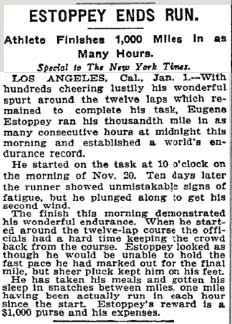A week or so ago I published an article on ultrarunning. A few days before publishing it I stumbled upon a mention of the "speed project" and I thought that it would be a great companion to the ultrarunning one.
Here I think it's time for a disclosure. When I started publishing this blog I was writing the articles one at a time. Whenever I had time I was publishing a lot but when I was pressed for time, like when I was travelling, keeping the blog alive was becoming a challenge. I soon understood that I could not go on living "hand to mouth". I was going to need reserves. So, I changed my way of working. Whenever I have time, say on week-ends, I am preparing a blog post for future consumption. Sometimes the article in question can lay dormant for months in a row. This is often the case with articles that do not deal with current events but are of a more technical character. In that way I could boost the publication frequency from just over 30 article per year to over 40 and in fact, for 2020 and 2021, to over 50. (The lockdown did help a little). As you may have noticed I make a point of illustrating the posts with images and I try to have an article appear on the first day of the month.
So the article on Backyard Ultra was written more than a year ago. But its companion on the Speed Project is fresh out of the presses. In fact what pushed me to try to find more about this crazy ultramarathon were the gorgeous images of people running in the desert.
So what is this all about? It started in 2013 when a bunch of friends decided to run from Los Angeles to Las Vegas, a distance of some 550 km, having to cross some really inhospitable places, like Death Valley. There are no real rules. There is no fixed route (only a prohibition to run on the highways). Thus the more adventurous participants try to find shortcuts that would allow them to save a few minutes. Not everybody is selected for the Speed Project. People usually apply (it's not clear how, since the race does not have a web-site) and then wait for an invitation to arrive. This calls for real motivation, but after all, one cannot embark on such a race without a solid motivation.
The format of the teams allows for a great freedom. The basic one is a 6 person team with 4 men and 2 women. That was the format of the very first race, the OG team. Over the years other formats made their appearance. There are pure feminine teams with 6 female runners. There are solo runners who decide to punish themselves running more than 500 km under the scorching sun. But of course freestyle teams are also allowed (if selected) without limit as to the number of participants. There are no rules for the relays. On can run one time or dozens of times, over 1 km or over 50 km. And nobody knows what is the best strategy (which of course depends on the team composition).
The race records are impressive. In 2023 an OG team finished the race in under 30 hours, 29 hours and 21 minutes exactly. But what is more impressive is the solo record and it is held by a woman. In 2023 Lucy Scholz covered the 547 km separating Los Angeles to Las Vegas in 84 hours and 45 minutes. Just do the maths, that's more than 6 km per hour (but should be over 10 km/hr when one counts the incompressible amount of time for all bodily functions, sleep being the most time-consuming).
A few years back I wrote about the Spartathlon and the Pheidippides Run. The distance of the latter is not very far from the one of the Speed Project: 490 km from Athens to Sparta and back. The only difference is that it is held in November and so the athletes do not have to run under the torrid greek sun. Last year the winner, Ivan Zaborski, literally exploded the record covering the distance in 52 hours and 52 minutes, and the second finisher was a woman, Irina Masanova, who also established a new record with 66 hours and 41 minutes. Typically less than 50 % of the participants to the Pheidippides Run manage to complete the race. There are no statistics concerning the Speed Project (in accordance with the deliberately secretive nature of the event) but since it is mainly a team event one expects the majority of the participating teams to complete the course.







